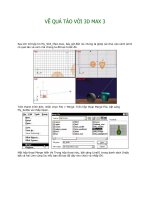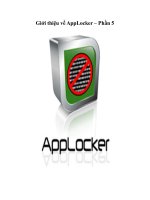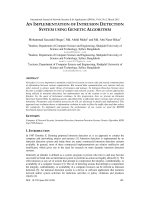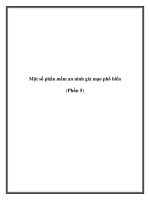Intrusion Detection Utilizing Ethereal phần 5 pptx
Bạn đang xem bản rút gọn của tài liệu. Xem và tải ngay bản đầy đủ của tài liệu tại đây (713.45 KB, 8 trang )
41
Figure 61. Lophtcrack accesses the registry to dump the SAM database
It took two minutes to crack the administrator password and hacker’s password. Daviesd’s password was
holding out a little bit longer, but it too cracked after about three minutes. ☺
SMBRelay:
This tool is capable of capturing SMB hashes or hijacking a session through a Man-In-The-Middle attack.
In order to perform this MITM attack a hacker has to either use ARP poisoning or send a malicious email
with code to cause the victim to connect to the hacker’s computer. Unfortunately, the traffic looks normal
and is something usually only detected on the client side (from strange errors due to having the session
dropped).
An example of using SMBRelay:
C:\ smbrelay /IL 2 /IR 2 /L+ 10.0.0.5 /R 10.0.0.15 /T 10.0.0.75
That concludes our review of NetBIOS and SMB. The learning curve can be steep at first due to the non-
ASCII commands used in Windows Networking. However, once the basic terminology and syntax is
learned, deciphering what a normal user or a malicious attacker is doing on your computer is not such a
daunting task.
42
Conclusion
Whether Ethereal is used online for exploit code and signature analysis, or offline to analyze suspicious
packets, it is a useful and powerful ally. Instead of looking at garbled data that a simpler tool like
tcpdump would produce, you get the capability to dig through each network layer either by hand or using
custom filters. Exploits that would normally be very difficult to detect can be caught in the midst of an
overload of extraneous data. Even for those that don’t want to get into the technical details can use option
like TCP Stream to give a clear overview of a connection. I didn’t even come close to covering all of the
protocols and exploits that Ethereal can analyze. Hopefully, by covering some of the more common
protocols (HTTP) and not so commonly analyzed protocols (SMB) you will see the range of options that
you possess. Are there other freeware and commercial tools out there to analyze network captures? Sure
there are. I’d argue, that for the price (free) and the many capabilities that Ethereal has, it would be tough
to find a close competitor.
Acknowledgements
I would like to thank Richard Bejtlich, Chuck Port, and the Incident Response Team for reviewing and
commenting on this paper.
Useful References
Ethereal:
Ethereal User Guide
/>
Tcpdump
/>
Web Traffic:
HTTP Status Codes
/>
Unicode (Directory Traversal)
/>
Http Authentication
/>
Buffer Overflows:
ADMmutate
/>
Teso Security Group
/>
43
Heap-based Overflows – w00w00 Security Development
Smashing the Stack for Fun and Profit
Backdoors:
Placing Backdoors Through Firewalls
ICMP Shell
/>
Covert Shells
NetBIOS/SMB:
SMB Exchange
SMB Commands
COTSE-NetBIOS Tools
/>
NT HACK FAQ
/>
Modern Hackers Desk Reference
Rhino9 Group
/>
NetBIOS Suffixes
/>
Named Pipes
Great information on SMB
SMB Protocol In-Depth
**SMB Protocol In-Depth**
smbpub.zip (SMB Full Documentation)
44
Tools:
ADMmutate
ICMP Shell (ISH)
Rwwwshell.pl
Lophtcrack (v3)
NAT
LANguard Network Scanner
Netbrute
Sid2User/User2Sid
Smbrelay
Additional NetBIOS/SMB Reference:
1.Excerpt from
SMB runs either over the NetBIOS Frames Protocol (NBF), NetBIOS over TCP/IP, or NetBIOS over
IPX.
SMB
Server Message Block (SMB)
/ | \
NetBIOS Frames Protocol (NBF)
ie NetBEUI ie NetBIOS
or
NetBIOS over TCP/IP
RFC 1001 RFC 1002
or NetBIOS over IPX
SMB Command Codes
Below is a table giving some of the Core SMB commands:
Core SMB Commands
Field Name smb_com Description
SMBmkdir 0x00 Create directory
SMBrmdir 0x01 Delete directory
SMBopen 0x02 Open file
SMBcreate 0x03 Create file
SMBclose 0x04 Close file
SMBflush 0x05 Commit all files
SMBunlink 0x06 Delete file
SMBmv 0x07 Rename file
SMBgetatr 0x08 Get file attribute
SMBsetatr 0x09 Set file attribute
45
SMBread 0x0a Read byte block
SMBwrite 0x0b Write byte block
SMBlock 0x0c Lock byte block
SMBunlock 0x0d Unlock byte block
SMBmknew 0x0f Create new file
SMBchkpth 0x10 Check directory
SMBexit 0x11 End of process
SMBlseek 0x12 LSEEK
SMBtcon 0x70 Start connection
SMBtdis 0x71 End connection
SMBnegprot 0x72 Verify dialect
SMBbskattr 0x80 Get disk attributes
SMBsearch 0x81 Search multiple files
SMBsplopen 0xc0 Create spool file
SMBsplwr 0xc1 Spool byte block
SMBsplclose 0xc2 Close spool file
SMBsplretq 0xc3 Return print queue
SMBsends 0xd0 Send message
SMBsendb 0xd1 Send broadcast
SMBfwdname 0xd2 Forward user name
SMBcancelf 0xd3 Cancel forward
SMBgetmac 0xd4 Get machine name
SMBsendstrt 0xd5 Start multi-block message
SMBsendend 0xd6 End multi-block message
SMBsendtxt 0xd7 Multi-block message text
Never valid 0xfe Invalid
Implementation-dependant 0xff Implementation-dependant
Below is a table giving some of the Core plus commands:
46
Core plus Commands
Field Name smb_com Description
SMBlockreadr 0x13 Lock then read data
SMBwriteunlock 0x14 Write then unlock data
SMBreadBraw 0x1a Read block raw
SMBwriteBraw 0x1d Write block raw
Below is a table giving some of the LANMAN 1.0 SMB commands:
LANMAN 1.0 SMB Commands
Field Name smb_com Description
SMBreadBmpx 0x1b Read block multiplexed
SMBreadBs 0x1c Read block (secondary response)
SMBwriteBmpx 0x1e Write block multiplexed
SMBwriteBs 0x1f Write block (secondary response)
SMBwriteC 0x20 Write complete response
SMBsetattrE 0x22 Set file attributes expanded
SMBgetattrE 0x23 Get file attributes expanded
SMBlockingX 0x24 Lock/unlock byte ranges and X
SMBtrans 0x25 Transaction (name, bytes in/out)
SMBtranss 0x26 Transaction (secondary request/response)
SMBioctl 0x27 Passes the IOCTL to the server
SMBioctls 0x28 IOCTL (secondary request/response)
SMBcopy 0x29 Copy
SMBmove 0x2a Move
SMBecho 0x2b Echo
SMBwriteclose 0x2c Write and Close
SMBopenX 0x2d Open and X
SMBreadX 0x2e Read and X
SMBwriteX 0x2f Write and X
SMBsesssetup 0x73 Session Set Up and X (including User Logon)
SMBtconX 0x75 Tree connect and X
SMBffirst 0x82 Find first
SMBfunique 0x83 Find unique
SMBfclose 0x84 Find close
SMBinvalid 0xfe Invalid command
47
SMB Error Class
Below is a table giving some of the SMB Error class values:
SMB Error Class
Field Name Value Description
SUCCESS 0x00 The request was successful
ERRSRV 0x02 Error generated by the LMX server
SMB Return Codes for Error class 0x00
Below is a table giving some of the SMB Return Code Values when the Error class is 0x00:
SMB Return Code
Field Name Value Description
BUFFERED 0x54 The Message was buffered
LOGGED 0x55 The Message was logged
DISPLAYED 0x56 The Message was displayed
SMB Return Codes for Error class 0x02
Below is a table giving some of the SMB Return Code Values when the Error class is 0x02:
SMB Return Code
Field Name Value Description
ERRerror 0x01 Non-specific error code
ERRbadpw 0x02 Bad password
ERRbadtype 0x03 Reserved
2. Excerpt from What is SMB? by Richard Sharpe ( />smb.html)
An Example SMB Exchange
The protocol elements (requests and responses) that clients and servers exchange are called SMBs. They
have a specific format that is very similar for both requests and responses. Each consists of a fixed size
header portion, followed by a variable sized parameter and data portion.
After connecting at the NetBIOS level, either via NBF, NetBT, etc, the client is ready to request services
from the server. However, the client and server must first identify which protocol variant they each
understand. The client sends a negprot SMB to the server, listing the protocol dialects that it understands.
The server responds with the index of the dialect that it wants to use, or 0xFFFF if none of the dialects
48
was acceptable. Dialects more recent than the Core and CorePlus protocols supply information in the
negprot response to indicate their capabilities (max buffer size, canonical file names, etc).
Once a protocol has been established. The client can proceed to logon to the server, if required. They do
this with a sesssetupX SMB.
The response indicates whether or not they have supplied a valid username password pair and if so, can
provide additional information. One of the most important aspects of the response is the UID of the
logged on user. This UID must be submitted with all subsequent SMBs on that connection to the server.
Once the client has logged on (and in older protocols-Core and CorePlus-you cannot logon), the client can
proceed to connect to a tree.
The client sends a tcon or tconX SMB specifying the network name of the share that they wish to connect
to, and if all is kosher, the server responds with a TID that the client will use in all future SMBs relating
to that share.
Having connected to a tree, the client can now open a file with an open SMB, followed by reading it with
read SMBs, writing it with write SMBs, and closing it with close SMBs.









